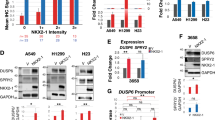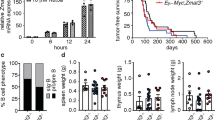Abstract
Mutations of the retinoblastoma tumor suppressor gene RB are frequently observed in human cancers, but rarely in non-small cell lung carcinomas (NSCLCs). Emerging evidence also suggests that the RB-related gene p130 is inactivated in a subset of human NSCLCs. To directly test the specific tumor suppressor roles of RB and p130 in NSCLC, we crossed Rb and p130 conditional mutant mice to mice carrying a conditional oncogenic K-Ras allele. In this model, controlled oncogenic K-Ras activation leads to the development of adenocarcinoma, a major subtype of NSCLC. We found that loss of p130 accelerated the death of mice, providing direct evidence in vivo that p130 is a tumor suppressor gene, albeit a weak one in this context. Loss of Rb increased the efficiency of lung cancer initiation and resulted in the development of high-grade adenocarcinomas and rapid death. Thus, despite the low frequency of RB mutations in human NSCLCs and reports that K-Ras activation and loss of RB function are rarely found in the same human tumors, loss of Rb clearly cooperates with activation of oncogenic K-Ras in lung adenocarcinoma development in mice.
This is a preview of subscription content, access via your institution
Access options
Subscribe to this journal
Receive 50 print issues and online access
$259.00 per year
only $5.18 per issue
Buy this article
- Purchase on Springer Link
- Instant access to full article PDF
Prices may be subject to local taxes which are calculated during checkout




Similar content being viewed by others
References
Cinti C, Macaluso M, Giordano A . (2005). Tumor-specific exon 1 mutations could be the ‘hit event’ predisposing Rb2/p130 gene to epigenetic silencing in lung cancer. Oncogene 24: 5821–5826.
Classon M, Harlow E . (2002). The retinoblastoma tumour suppressor in development and cancer. Nat Rev Cancer 2: 910–917.
Classon M, Salama S, Gorka C, Mulloy R, Braun P, Harlow E . (2000). Combinatorial roles for pRB, p107, and p130 in E2F-mediated cell cycle control. Proc Natl Acad Sci USA 97: 10820–10825.
Claudio PP, Caputi M, Giordano A . (2000). The RB2/p130 gene: the latest weapon in the war against lung cancer? Clin Cancer Res 6: 754–764.
Cobrinik D, Lee MH, Hannon G, Mulligan G, Bronson RT, Dyson N et al. (1996). Shared role of the pRB-related p130 and p107 proteins in limb development. Genes Dev 10: 1633–1644.
Dannenberg JH, Schuijff L, Dekker M, van der Valk M, te Riele H . (2004). Tissue-specific tumor suppressor activity of retinoblastoma gene homologs p107 and p130. Genes Dev 18: 2952–2962.
Dannenberg JH, te Riele HP . (2006). The retinoblastoma gene family in cell cycle regulation and suppression of tumorigenesis. Results Probl Cell Differ 42: 183–225.
DeGregori J . (2006). Surprising dependency for retinoblastoma protein in ras-mediated tumorigenesis. Mol Cell Biol 26: 1165–1169.
Geng Y, Eaton EN, Picon M, Roberts JM, Lundberg AS, Gifford A et al. (1996). Regulation of cyclin E transcription by E2Fs and retinoblastoma protein. Oncogene 12: 1173–1180.
Grasemann C, Gratias S, Stephan H, Schuler A, Schramm A, Klein-Hitpass L et al. (2005). Gains and overexpression identify DEK and E2F3 as targets of chromosome 6p gains in retinoblastoma. Oncogene 24: 6441–6449.
Greenlee RT, Hill-Harmon MB, Murray T, Thun M . (2001). Cancer statistics, 2001. CA Cancer J Clin 51: 15–36.
Jackson EL, Olive KP, Tuveson DA, Bronson R, Crowley D, Brown M et al. (2005). The differential effects of mutant p53 alleles on advanced murine lung cancer. Cancer Res 65: 10280–10288.
Jackson EL, Willis N, Mercer K, Bronson RT, Crowley D, Montoya R et al. (2001). Analysis of lung tumor initiation and progression using conditional expression of oncogenic K-ras. Genes Dev 15: 3243–3248.
Johnson DG, Ohtani K, Nevins JR . (1994). Autoregulatory control of E2F1 expression in response to positive and negative regulators of cell cycle progression. Genes Dev 8: 1514–1525.
Kaye FJ . (2002). RB and cyclin dependent kinase pathways: defining a distinction between RB and p16 loss in lung cancer. Oncogene 21: 6908–6914.
Lara MF, Santos M, Ruiz S, Segrelles C, Moral M, Martinez-Cruz AB et al. (2008). p107 acts as a tumor suppressor in pRb-deficient epidermis. Mol Carcinog 47: 105–113.
Lee KY, Ladha MH, McMahon C, Ewen ME . (1999). The retinoblastoma protein is linked to the activation of Ras. Mol Cell Biol 19: 7724–7732.
Meuwissen R, Linn SC, Linnoila RI, Zevenhoven J, Mooi WJ, Berns A . (2003). Induction of small cell lung cancer by somatic inactivation of both Trp53 and Rb1 in a conditional mouse model. Cancer Cell 4: 181–189.
Mulligan GJ, Wong J, Jacks T . (1998). p130 is dispensable in peripheral T lymphocytes: evidence for functional compensation by p107 and pRB. Mol Cell Biol 18: 206–220.
Olsson AY, Feber A, Edwards S, Te Poele R, Giddings I, Merson S et al. (2006). Role of E2F3 expression in modulating cellular proliferation rate in human bladder and prostate cancer cells. Oncogene 26: 1028–1037.
Rodenhuis S, Slebos RJ . (1990). The ras oncogenes in human lung cancer. Am Rev Respir Dis 142: S27–S30.
Ruiz S, Santos M, Lara MF, Segrelles C, Ballestin C, Paramio JM . (2005). Unexpected roles for pRb in mouse skin carcinogenesis. Cancer Res 65: 9678–9686.
Sage J, Miller AL, Perez-Mancera PA, Wysocki JM, Jacks T . (2003). Acute mutation of retinoblastoma gene function is sufficient for cell cycle re-entry. Nature 424: 223–228.
Sage J, Mulligan GJ, Attardi LD, Miller A, Chen S, Williams B et al. (2000). Targeted disruption of the three Rb-related genes leads to loss of G(1) control and immortalization. Genes Dev 14: 3037–3050.
Sherr CJ, McCormick F . (2002). The RB and p53 pathways in cancer. Cancer Cell 2: 103–112.
Suzuki T, Minehata K, Akagi K, Jenkins NA, Copeland NG . (2006). Tumor suppressor gene identification using retroviral insertional mutagenesis in Blm-deficient mice. EMBO J 25: 3422–3431.
Takahashi C, Bronson RT, Socolovsky M, Contreras B, Lee KY, Jacks T et al. (2003). Rb and N-ras function together to control differentiation in the mouse. Mol Cell Biol 23: 5256–5268.
Takahashi C, Contreras B, Bronson RT, Loda M, Ewen ME . (2004). Genetic interaction between Rb and K-ras in the control of differentiation and tumor suppression. Mol Cell Biol 24: 10406–10415.
Takahashi C, Contreras B, Iwanaga T, Takegami Y, Bakker A, Bronson RT et al. (2006). Nras loss induces metastatic conversion of Rb1-deficient neuroendocrine thyroid tumor. Nat Genet 38: 118–123.
Takahashi C, Ewen ME . (2006). Genetic Interaction between Rb and N-ras: Differentiation Control and Metastasis. Cancer Res 66: 9345–9348.
Tedesco D, Lukas J, Reed SI . (2002). The pRb-related protein p130 is regulated by phosphorylation-dependent proteolysis via the protein-ubiquitin ligase SCF(Skp2). Genes Dev 16: 2946–2957.
Travis WD, Travis LB, Devesa SS . (1995). Lung cancer. Cancer 75: 191–202.
Tuveson DA, Shaw AT, Willis NA, Silver DP, Jackson EL, Chang S et al. (2004). Endogenous oncogenic K-ras(G12D) stimulates proliferation and widespread neoplastic and developmental defects. Cancer Cell 5: 375–387.
Wikenheiser-Brokamp KA . (2004). Rb family proteins differentially regulate distinct cell lineages during epithelial development. Development 131: 4299–4310.
Wikenheiser-Brokamp KA . (2006). Retinoblastoma family proteins: insights gained through genetic manipulation of mice. Cell Mol Life Sci 63: 767–780.
Williams JP, Stewart T, Li B, Mulloy R, Dimova D, Classon M . (2006). The retinoblastoma protein is required for Ras-induced oncogenic transformation. Mol Cell Biol 26: 1170–1182.
Wistuba II, Gazdar AF, Minna JD . (2001). Molecular genetics of small cell lung carcinoma. Semin Oncol 28: 3–13.
Acknowledgements
We thank Drs Erica Jackson and Alejandro Sweet-Cordero for critical reading of the article and Dr Jeffrey Whitsett for the generous gift of SP-C antibodies. This work was supported by a Damon Runyon Cancer Research Foundation Scholar Award (JS) and by a post-doctoral fellowship from the American Lung Association (KP).
Author information
Authors and Affiliations
Corresponding author
Additional information
Supplementary Information accompanies the paper on the Oncogene website (http://www.nature.com/onc)
Rights and permissions
About this article
Cite this article
Ho, V., Schaffer, B., Karnezis, A. et al. The retinoblastoma gene Rb and its family member p130 suppress lung adenocarcinoma induced by oncogenic K-Ras. Oncogene 28, 1393–1399 (2009). https://doi.org/10.1038/onc.2008.491
Received:
Revised:
Accepted:
Published:
Issue Date:
DOI: https://doi.org/10.1038/onc.2008.491
Keywords
This article is cited by
-
RB constrains lineage fidelity and multiple stages of tumour progression and metastasis
Nature (2019)
-
Cyclin D–CDK4 relieves cooperative repression of proliferation and cell cycle gene expression by DREAM and RB
Oncogene (2019)
-
Manipulating the tumour-suppressor protein Rb in lung cancer reveals possible drug targets
Nature (2019)
-
RBL2/p130 is a direct AKT target and is required to induce apoptosis upon AKT inhibition in lung cancer and mesothelioma cell lines
Oncogene (2018)
-
A quantitative and multiplexed approach to uncover the fitness landscape of tumor suppression in vivo
Nature Methods (2017)



